Coastal Remote Sensing: Merging Physical, Chemical, and Biological Data as Tailings Drift onto Buffalo Reef, Lake Superior
Abstract
:1. Introduction
2. Materials and Methods
2.1. Obtaining LiDAR Information on Bay Substrates
2.2. Ponar Sampling (In Situ Measurements)
2.3. Determination of Stamp Sand Percentages in Sand Grain Mixtures
2.4. Manganese Grain Correction
2.5. Cu Concentrations: Predictions from % SS Versus Directly Assayed Samples
2.6. Benthic Invertebrate Surveys
2.7. Map Construction Techniques
3. Results
3.1. Non-Nadir LiDAR Bathymetry
3.2. Determining Percentages of Stamp Sand in Sand Mixtures Across the Bay
3.3. Sediment Copper Concentrations: Values Predicted from % Stamp Sand Compared with Direct Assays (Regression Analysis)
3.4. Benthic Invertebrate Community Survey
4. Discussion
4.1. Coastal Issues: United Nations Environmental Programme Addresses Mining Discharges
4.2. How Remote Sensing Has Aided Studies of Tailings Impacts Across Grand (Big) Traverse Bay
4.3. Contouring: Use of The Kernel Method with Barriers (% SS, Cu Concentrations); Application of Kriging (EBK) to Macroinvertebrate Data
4.4. Toxicity: Shoreline and Underwater
4.5. Active and Pending Mitigation Measures
Supplementary Materials
Author Contributions
Funding
Data Availability Statement
Acknowledgments
Conflicts of Interest
References
- Vogt, C. International Assessment of Marine and Riverine Disposal of Mine Tailings. In Proceedings of the Secretariat, London Convention/London Protocol, International Maritime Organization, London, England & United Nations Environment Programme-Global Program of Action, London, UK, 1 November 2012; p. 134. [Google Scholar]
- Kemp, A.L.W.; Williams, J.D.H.; Thomas, R.L.; Gregory, M.L. Impact of man’s activities on the chemical composition of the sediments of Lakes Superior and Huron. Water Air Soil Pollut. 1978, 10, 381–402. [Google Scholar] [CrossRef]
- Kerfoot, W.C.; Nriagu, J.O. Copper mining, copper cycling and mercury in the Lake Superior ecosystem: An introduction. J. Great Lakes Res. 1999, 25, 594–598. [Google Scholar] [CrossRef]
- Kerfoot, W.C.; Jeong, J.; Robbins, J.A. Lake Superior mining and the proposed Mercury Zero-discharge Region. In State Lake Superior; Munawar, M., Ed.; Aquatic Ecosystem Health and Management Society: Burlington, ON, Canada, 2009; pp. 153–216. [Google Scholar]
- Langston, N. Sustaining Lake Superior. An Extraordinary Lake in a Changing World; Yale University Press: New Haven, CT, USA, 2017. [Google Scholar]
- Kerfoot, W.C.; Rossmann, R.; Robbins, J.A. Elemental mercury in copper, silver, and gold ores: An unexpected contribution to Lake Superior sediments with global implications. Geochem. Explor. Env. Anal. 2002, 2, 185–202. [Google Scholar] [CrossRef]
- Kerfoot, W.C.; Harting, S.L.; Jeong, J.; Robbins, J.A.; Rossmann, R. Local, regional and global implications of elemental mercury in metal (copper, silver, gold, and zinc) ores: Insights from Lake Superior sediments. J. Great Lakes Res. 2004, 52, 162–184. [Google Scholar] [CrossRef]
- Gewurtz, S.B.; Shen, L.; Helm, P.A.; Waltho, J.; Reiner, E.J.; Painter, S.; Brindle, I.D.; Marvin, C.H. Spatial distributions of legacy contaminants in sediments of lakes Huron and Superior. J. Great Lakes Res. 2008, 34, 153–168. [Google Scholar] [CrossRef]
- Kraft, K. Pontoporeia distribution along the Keweenaw shore of Lake Superior affected by copper tailings. J. Great Lakes Res. 1979, 7, 258–263. [Google Scholar] [CrossRef]
- Kerfoot, W.C.; Lauster, G.; Robbins, J.A. Paleolimnological study of copper mining around Lake Superior: Artificial varves from Portage Lake provide a high resolution record. Limnol. Oceanogr. 1994, 39, 649–669. [Google Scholar] [CrossRef]
- Kerfoot, W.C.; Yousef, F.; Green, S.A.; Regis, R.; Shuchman, R.; Brooks, C.N.; Sayers, M.; Sabol, B.; Graves, M. Light Detection and Ranging (LiDAR) and multispectral studies of disturbed Lake Superior coastal environments. Limnol. Oceanogr. 2012, 57, 749–771. [Google Scholar] [CrossRef]
- Kerfoot, W.C.; Hobmeier, M.M.; Yousef, F.; Green, S.A.; Regis, R.; Brooks, C.N.; Shuchman, R.; Anderson, J.; Reif, M. Light detection and ranging (LiDAR) and Multispectral Scanner (MSS) studies examine coastal environments influenced by mining. ISPRS Int. J. Geo. Inf. 2014, 3, 66–95. [Google Scholar] [CrossRef] [Green Version]
- Kerfoot, W.C.; Hobmeier, M.M.; Green, S.A.; Yousef, F.; Brooks, C.N.; Shuchman, R.; Sayers, M.; Lin, L.; Luong, P.; Hayter, E.; et al. Coastal ecosystem investigations with LiDAR (Light Detection and Ranging) and bottom reflectance: Lake Superior reef threatened by migrating tailings. Remote Sens. 2019, 11, 1076. [Google Scholar] [CrossRef] [Green Version]
- Yousef, F.; Kerfoot, W.C.; Brooks, C.N.; Shuchman, R.; Sabol, B.; Graves, M. Using LiDAR to reconstruct the history of a coastal environment influenced by legacy mining. J. Great Lakes Res. 2013, 39, 205–216. [Google Scholar] [CrossRef]
- Kerfoot, W.C.; Hobmeier, M.M.; Regis, R.; Raman, V.K.; Brooks, C.N.; Shuchman, R.; Sayers, M.; Yousef, F.; Reif, M. Lidar (light detection and ranging) and benthic invertebrate investigations: Migrating tailings threaten Buffalo reef in Lake Superior. J. Great Lakes Res. 2019, 45, 872–887. [Google Scholar] [CrossRef]
- Babcock, L.L.; Spiroff, K. Mine and Mill Origin, Sampling and Mineralogy of Stamp Sand. In Recovery of Copper from Michigan Stamp Sands; U.S. Department of Interior, Bureau of Mines, Project G0180241; Institute of Mineral Research, Michigan Technological University: Houghton, MI, USA, 1970; Volume 1. [Google Scholar]
- Sloss, P.W.; Saylor, J.H. Large-scale Current Measurements in Lake Superior; NOAA Technical Report ERL 363-GLERL 8; Great Lakes Environmental Research Laboratory: Ann Arbor, MI, USA, 1976. [Google Scholar]
- Weston Solutions of Michigan, Inc. Migrating Stamp Sand Mitigation Plan Technical Evaluation; Remediation and Redevelopment Division: Chilton, MI, USA, 2007.
- Hayter, E.J.; Chapman, R.S.; Lin, L.; Luong, P.V.; Mausolf, G.; Perkey, D.; Mark, D.; Gailani, J. Modeling Sediment Transport in Grand Traverse Bay, Michigan to Determine Effectiveness of Proposed Revetment at Reducing Transport of Stamp Sands onto Buffalo Reef; ERDC Letter Report; U.S.A.C.E. ERDC Laboratory: Vicksburg, MS, USA, 2015; p. 71. [Google Scholar]
- Ackermann, F. Airborne laser scanning-present status and future expectations. J. Photogram. Remote Sens. 1999, 54, 64–67. [Google Scholar] [CrossRef]
- Reif, M.K.; Wozencraft, J.M.; Dunkin, L.M.; Sylvester, C.S.; Macon, C.L. A review of US Army Corps of Engineers airborne coastal mapping in the Great Lakes. J. Great Lakes Res. 2013, 39, 194–204. [Google Scholar] [CrossRef]
- Banks, K.W.; Riegal, B.M.; Shinn, E.A.; Piller, W.E.; Dedge, R.E. Geomorphology of the Southeast Florida continental reef tract (Miami-Dade, Broward and Palm Beach Counties, USA). Coral Reefs 2007, 26, 617–633. [Google Scholar] [CrossRef]
- LeRocque, P.E.; West, G.R. Airborne Laser Hydrography: An Introduction. In Proceedings of the ROPME/PERSGA/IHB Workshop on Hydrographic Activities in the ROPME Sea Area and Red Sea, Kuwait City, Kuwait, 24–27 October 1990. [Google Scholar]
- Abdallah, H.; Bailly, J.; Baghdadi, N.; Saint-Geours, N.; Fabre, F. Potential of space-borne LiDAR sensors for global bathymetry in coastal and inland waters. IEEE J. Sel. Top. Appl. Earth Obs. Remote. Sens. 2013, 6, 202–216. [Google Scholar] [CrossRef] [Green Version]
- Guenther, G.C.; Cunningham, A.G.; LaRocque, P.E.; Reid, D.J. Meeting the Accuracy Challenge in Airborne Lidar Bathymetry. In Proceedings of the EARSel-SIG-Workshop LIDAR, Dresden, Germany, 15–17 June 2000. EARSel: 2001. [Google Scholar]
- Zhao, J.; Zhao, X.; Zhang, H.; Zhou, F. Improved model for depth bias correction in airborne LiDAR bathymetry systems. Remote Sens. 2017, 9, 710. [Google Scholar] [CrossRef] [Green Version]
- Yeu, Y.; Yee, J.; Yun, H.S.; Kim, K.B. Evaluation of the accuracy of bathymetry on the nearshore coastlines of Western Korea from satellite altimetry, multi-beam, and airborne bathymetric LIDAR. Sensors 2018, 18, 2926. [Google Scholar] [CrossRef] [Green Version]
- Reutebuch, S.E.; McGaughey, R.J.; Andersen, H.E.; Carson, W.W. Accuracy of a high-resolution lidar terrain model under a conifer forest. Can. J. Remote. Sens. 2003, 29, 527–535. [Google Scholar] [CrossRef]
- Gerhard, J. Vital Deployment of Lidar Data for Emergency Response-Rapid, Effective, Essential; Lidar Magazine: 2018. Available online: https://woolpert.com/resource/vital-deployment-of-lidar-data-for-emergency-response-rapid-effective-essential/ (accessed on 1 January 2021).
- Biberhofer, J.; Procopec, C.M. Delineation and Characterization of Aquatic Substrate Features on or adjacent to Buffalo Reef, Keweenaw Bay, Lake Superior; Technical Note AERMB-TN06; Environment Canada National Water Resource Institute (NWRI): Burlington, ON, Canada, 2008. [Google Scholar]
- Flannagan, J.F. Efficiencies of various grabs and corers in sampling freshwater benthos. Fish. Res. Board Can. 1970, 27, 1691–1700. [Google Scholar] [CrossRef]
- Powers, C.F.; Robertson, A. Design and evaluation of an all-purpose benthos sampler. Great Lakes Res. Div. Univ. Mich. Spec. Rep. 1967, 30, 126–131. [Google Scholar]
- Bingham, C.R.; Mathis, D.B.; Sanders, L.G.; McLemore, E. Grab Samplers for Benthic Macroinvertebrates in the Lower Mississippi River; Misc. Paper E-82-3; Army Engineer Waterways Experimental Station, CE: Vicksburg, MS, USA, 1982. [Google Scholar]
- Johnson, T.C. Sedimentation in large lakes. Annu. Rev. Earth Planet. Sci. 1984, 12, 179–204. [Google Scholar] [CrossRef]
- Kerfoot, W.C.; Robbins, J.A. Nearshore regions of Lake Superior: Multi-element signatures of mining discharges and a test of Pb-210 deposition under conditions of variable sediment mass flux. J. Great Lakes Res. 1999, 25, 697–720. [Google Scholar] [CrossRef]
- Jeong, J.; Urban, N.R.; Green, S. Release of copper from mine tailings on the Keweenaw Peninsula. J. Great Lakes Res. 1999, 25, 721–734. [Google Scholar] [CrossRef]
- MDEQ. Toxicological Evaluation for the Gay, Michigan Stamp Sand; Weston Solutions, W.O. No. 20083.032.002; Remediation and Redevelopment Division, Calumet Field Office: Calumet, MI, USA, 2006. [Google Scholar]
- Zanko, L.M.; Patelke, M.M.; Mack, P. Keweenaw Peninsula (Gay, Michigan) Stamp Sand Area Assessment; Technical Summary Report. NRRI (Natural Resources Research Institute)/TSR-2013/01; University of Minnesota: Duluth, MN, USA, 2013. [Google Scholar]
- Malueg, K.W.; Schuytema, G.S.; Krawczyk, D.F.; Gakstatter, J.H. Laboratory sediment toxicity tests, sediment chemistry and distribution of benthic macroinvertebrates in sediments from the Keweenaw Waterway, Michigan. Env. Toxicol. Chem. 1984, 3, 233–242. [Google Scholar] [CrossRef]
- Ankley, G.T.; Mattson, V.R.; Leonard, E.N.; West, C.W.; Bennet, J.L. Predicting the acute toxicity of copper in freshwater sediments: Evaluation of the role of acid volatile sulfide. Environ. Toxicol. Chem. 1993, 11, 315–320. [Google Scholar] [CrossRef]
- Pennak, R.W. Fresh-Water Invertebrates of the United States. Porifera to Mollusca, 3rd ed.; John Wiley & Sons, Inc.: New York, NY, USA, 1989. [Google Scholar]
- Thorp, J.H.; Covich, A.P. Ecology and Classification of North American Freshwater Invertebrates, 2nd ed.; Academic Press: San Diego, CA, USA, 2001. [Google Scholar]
- Gribov, A.; Krivoruchko, K. Local polynomials for data detrending and interpolation in the presence of barriers. Stoch. Environ. Res. Risk Assess. 2011, 25, 1057–1063. [Google Scholar] [CrossRef]
- Wand, M.P.; Jones, M.C. Kernel Smoothing; CRC Press: Boca Raton, FL, USA, 1994. [Google Scholar]
- Diggle, P.J.; Ribeiro Jr, P.J. Bayesian inference in Gaussian model-based geostatistics. Geogr. Environ. Model. 2002, 6, 129–146. [Google Scholar] [CrossRef]
- Kerfoot, W.C.; Robbins, J.R.; Weider, L.J. A new approach to historical reconstruction: Combining descriptive and experimental paleolimnology. Limnol. Oceanogr. 1999, 44, 1232–1247. [Google Scholar] [CrossRef] [Green Version]
- MacDonald, D.D.; Ingersoll, C.G.; Berger, T.A. Development and evaluation of consensus-based sediment quality guidelines for freshwater ecosystems. Arch. Environ. Contam. Toxicol. 2000, 39, 20–31. [Google Scholar] [CrossRef]
- MDEQ. A Sediment Chemistry of Lake Superior Shoreline in the Vicinity of Gay, Keweenaw and Houghton Counties; Michigan, August 26,27, and 28, 2008; Staff Report MI/DEQ/WRD-12/023; MDEQ: Lansing, MI, USA, 2012; p. 35. [Google Scholar]
- Chiriboga, E.D.; Mattes, W.P. Buffalo Reef and Substrate Mapping Project; Administrative Report 08-04; Great Lakes Indian Fish and Wildlife Commission (GLIFWC): Odanah, WI, USA, 2008. [Google Scholar]
- Collins, A.L.; Pulley, S.; Foster, D.L.; Gellis, A.; Porto, P.; Horowitz, A.J. Sediment source fingerprinting as an aid to catchment management: A review of the current state of knowledge and a methodological decision-tree for end-users. J. Environ. Manag. 2017, 194, 86–108. [Google Scholar] [CrossRef] [Green Version]
- UNEP/GPA. United Nations Environment Programme: Global Program of Action for the Protection of the Marine Environment from Land-Based Activities, Adopted by Over 108 Governments; UNEP/GPA: Washington, DC, USA, 3 November 1995. [Google Scholar]
- Kerfoot, W.C.; Urban, N.; Jeong, J.; MacLennan, C.; Ford, S. Copper-rich “halo” off Lake Superior’s Keweenaw Peninsula and how Mass Mill tailings dispersed onto tribal lands. J. Great Lakes Res. 2020. [Google Scholar] [CrossRef]
- Kennedy, A.D.; Chernosky, F.J. Recovery of Copper from Michigan Stamp Sands. Volume III Concentration Tests; For U.S. Dept. of Interior, Bureau of Mines, Project G0180241; Institute of Mineral Research, Michigan Technological University: Houghton, MI, USA, 1970. [Google Scholar]
- Budd, J.; Kerfoot, W.C.; Pilant, D.; Jipping, J.M. The Keweenaw Current and ice rafting: Use of satellite imagery to investigate copper-rich particle dispersal. J. Great Lakes Res. 1999, 25, 642–662. [Google Scholar] [CrossRef]
- Kerfoot, W.C.; Weider, L.J. Experimental paleoecology (resurrection ecology): Chasing Van Valen’s Red Queen hypothesis. Limnol. Oceanogr. 2004, 49, 1300–1316. [Google Scholar] [CrossRef] [Green Version]
- Lankton, L. Hollowed Ground: Copper Mining and Community Building On Lake Superior 1840s–1990s; Wayne State University Press: Detroit, MI, USA, 2010. [Google Scholar]
- Agassiz, L.; Cabot, J.E. Lake Superior: Its Physical Character, Vegetation, and Animals, Compared with Those of Other and Similar Regions. In Gould, Kendall and Lincoln; Natural History: Boston, MA, USA, 1850; p. 428. [Google Scholar]
- Kerfoot, W.C.; Budd, J.W.; Green, S.A.; Cotner, J.B.; Biddanda, H.A.; Schwab, D.J.; Vanderploeg, H.A. Doughnut in the desert: Late-winter production pulse in southern Lake Michigan. Limnol. Oceanogr. 2008, 53, 589–604. [Google Scholar] [CrossRef]
- Kerfoot, W.C.; Yousef, F.; Green, S.A.; Budd, J.W.; Schwab, D.J.; Vanderploeg, H.A. Approaching storm: Disappearing winter bloom in Lake Michigan. J. Great Lakes Res. 2010, 36, 30–41. [Google Scholar] [CrossRef]
- Shuchman, R.A.; Leshkevich, G.; Sayers, M.J.; Johengen, T.H.; Brooks, C.N.; Pozdnyakov, D. An algorithm to retrieve chlorophyll, dissolved organic carbon, and suspended minerals from Great Lakes satellite data. J. Great Lakes Res. 2013, 39, 14–33. [Google Scholar] [CrossRef]
- Wang, Y. (Ed.) Remote Sensing Of Coastal Environments; CRC Press: Boca Raton, FL, USA, 2010. [Google Scholar]
- Marullo, S.; Patsaeva, S.; Fiorani, L. (Eds.) Remote sensing of the coastal zone of the European seas. Intern. J. Remote Sens. 2018, 39, 24. [Google Scholar]
- Chust, G.; Galparsoro, I.; Boria, A.; Franco, J.; Uriarte, A. Coastal and eustuarine habitat mapping, using LiDAR height and intensity and multi-spectral imagery. Estuar. Coast. Shelf Sci. 2008, 78, 633–643. [Google Scholar] [CrossRef]
- Tuell, G.; Barbor, K.; Wozencraft, J. Overview of the Coastal Zone Mapping and Imaging LiDAR (CZMIL): A new multi-sensor airborne mapping system for the U.S. Army Corps of Engineers. Proc. SPIE Int. Soc. Opt. Eng. 2010, 7695, 1–8. [Google Scholar] [CrossRef]
- Maxwell, A.E.; Warner, T.A.; Strager, M.P.; Pai, M. Combining Rapideye satellite imagery and Lidar for mapping of mining and mine reclamation. Photogramm. Eng. Sens. 2014, 80, 179–189. [Google Scholar] [CrossRef]
- Jensen, J.R. Introductory Digital Image Processing: A Remote Sensing Perspective, 3rd ed.; Prentice Hall PTR: Upper Saddle River, NJ, USA, 2004. [Google Scholar]
- Rasmussen, T.; Fraser, R.; Lemberg, D.S.; Regis, R. Mapping stamp sand dynamics: Gay, Michigan. J. Great Lakes Res. 2002, 28, 276–284. [Google Scholar] [CrossRef]
- Kerfoot, W.C.; Green, S.A.; Brooks, C.; Sayers, M.; Feen, M.; Sawtell, R.; Shuchman, R.; Reif, M. Stamp Sand Threat to Buffalo Reef & Grand Traverse Bay: LiDAR/MSS Assessments Prior to “Trough” Dredging; GLNPO/USACE Report; U.S.A.C.E.: Detroit, MI, USA, 2017; p. 87. [Google Scholar]
- Auer, N.A.; Kahn, J.E. Abundance and distribution of benthic invertebrates, with emphasis on Diporeia, along the Keweenaw Peninsula, Michigan. J. Great Lakes Res. 2004, 30, 369–384. [Google Scholar] [CrossRef]
- Auer, M.T.; Auer, N.A.; Urban, N.R.; Auer, T. Distribution of the amphipod Diporeia in Lake Superior. The ring of fire. J. Great Lakes Res. 2013, 39, 33–46. [Google Scholar] [CrossRef]
- Lytle, R.D. In situ copper toxicity tests: Applying likelihood ratio tests to Daphnia pulex incubations in Keweenaw Peninsula waters. J. Great Lakes Res. 1999, 25, 744–759. [Google Scholar] [CrossRef]
- Turner, W.; Spector, S.; Gardiner, N.; Flandeland, M.; Sterling, E.; Steininger, M. Remote sensing for biodiversity science and conservation. Trends Ecol. Evol. 2003, 18, 306–314. [Google Scholar] [CrossRef]
- Harris, C.A.; Scott, A.P.; Johnson, A.C.; Panter, G.H.; Sheahan, D.; Roberts, M.; Sumpter, J.P. Principles of sound ecotoxicology. Environ. Sci. Technol. 2014, 48, 3100–3111. [Google Scholar] [CrossRef] [PubMed] [Green Version]
- Schubauer-Berigan, M.K.; Dierkes, J.R.; Monson, P.D.; Ankley, G.T. pH-dependent toxicity of Cd, Cu, Ni, Pb, and Zn to Ceriodaphnia dubia, Pimephales promelus, Hyalella azteca and Lumbriculus variegates. Environ. Toxic. Chem. 1993, 12, 1261–1266. [Google Scholar] [CrossRef]
- West, C.W.; Mattson, V.R.; Leonard, E.N.; Phipps, G.L.; Ankley, G.T. Comparison of the relative sensitivity of three benthic invertebrates to copper contaminated sediments from the Keweenaw Waterway. Hydrobiologia 1993, 262, 57–68. [Google Scholar] [CrossRef]
- Michaels, B. Big Traverse Bay Stamp Sands; doczz.net/doc/4317288/big-traverse-bay-stamp-sands—Great–Lakes-Fishery-Commission GLIFWC: Odanah, WI, USA, 2016. [Google Scholar]
- GLIFWC. Keweenaw County, Michigan—Gay Stamp Sands: Comments on the Proposed GLFER Project; Whitepaper, GLIFWC; Great Lakes Indian Fish and Wildlife Commission (GLIFWC): Odanah, WI, USA, 2012; p. 8. [Google Scholar]
- Ridge, J.T.; Gray, P.; Windle, A.; Johnston, D.W. Deep learning for coastal resource conservation: Automating detection of shellfish reefs: Deep Learning for Coastal Conservation. Remote. Sens. Ecol. Conserv. 2020, 6. [Google Scholar] [CrossRef]
- Gray, P.C.; Fleisman, A.B.; Klein, D.J.; Mckown, M.W.; Bezy, S.V.; Lohmann, K.J.; Johnston, D.W. A convolutional neural network for detecting sea turtles in drone imagery. Methods Ecol. Evol. 2019, 10, 345–355. [Google Scholar] [CrossRef]

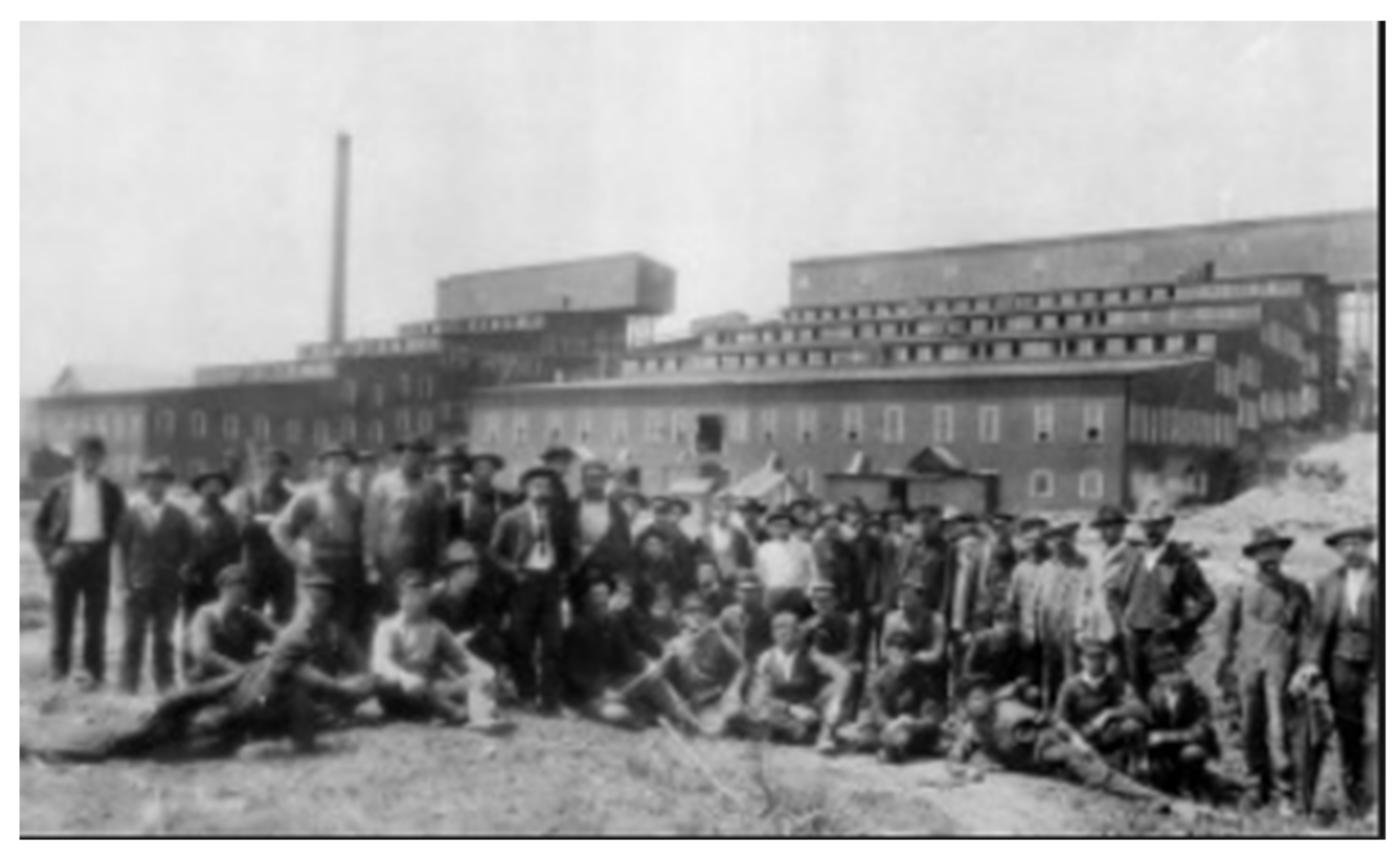
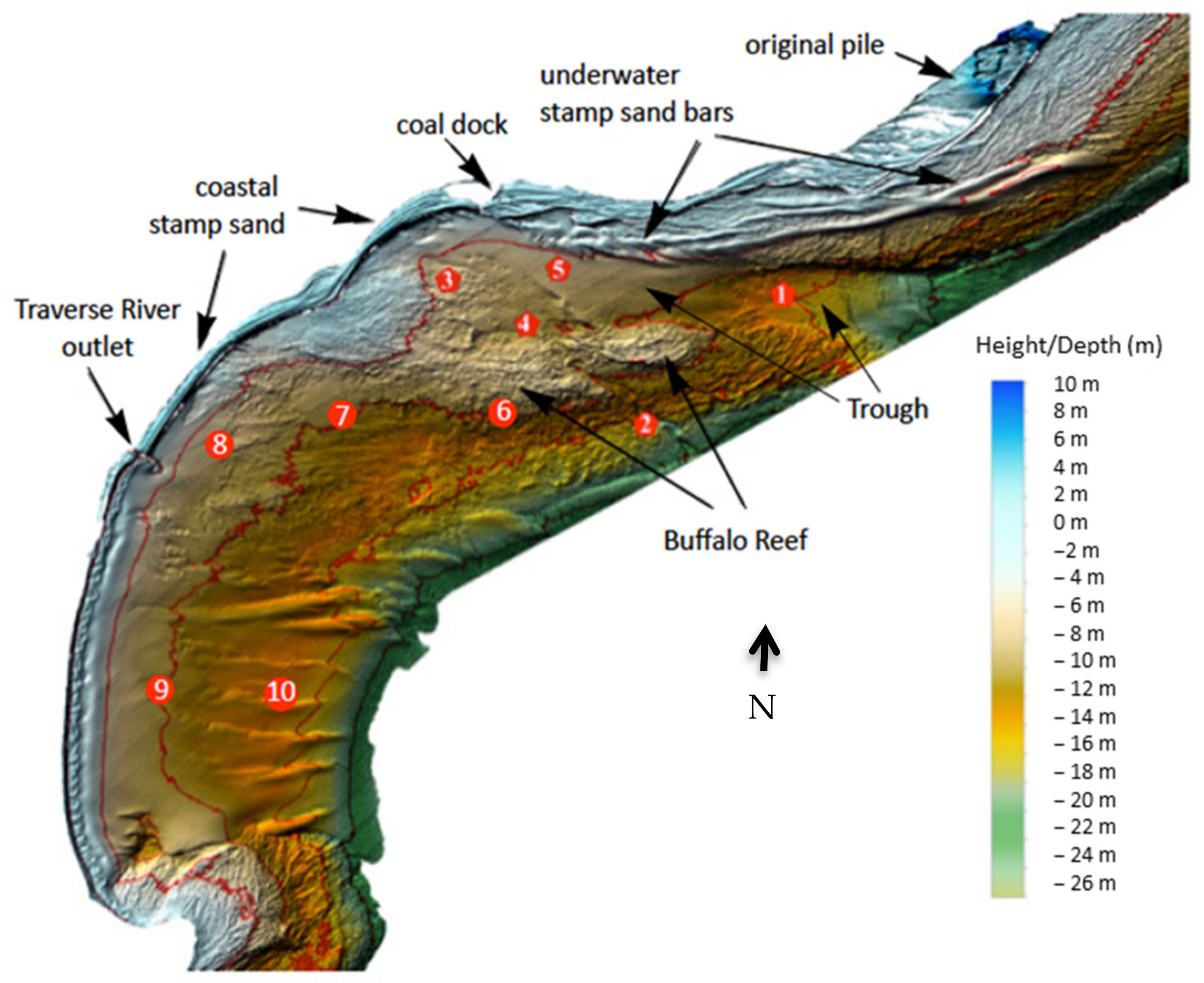
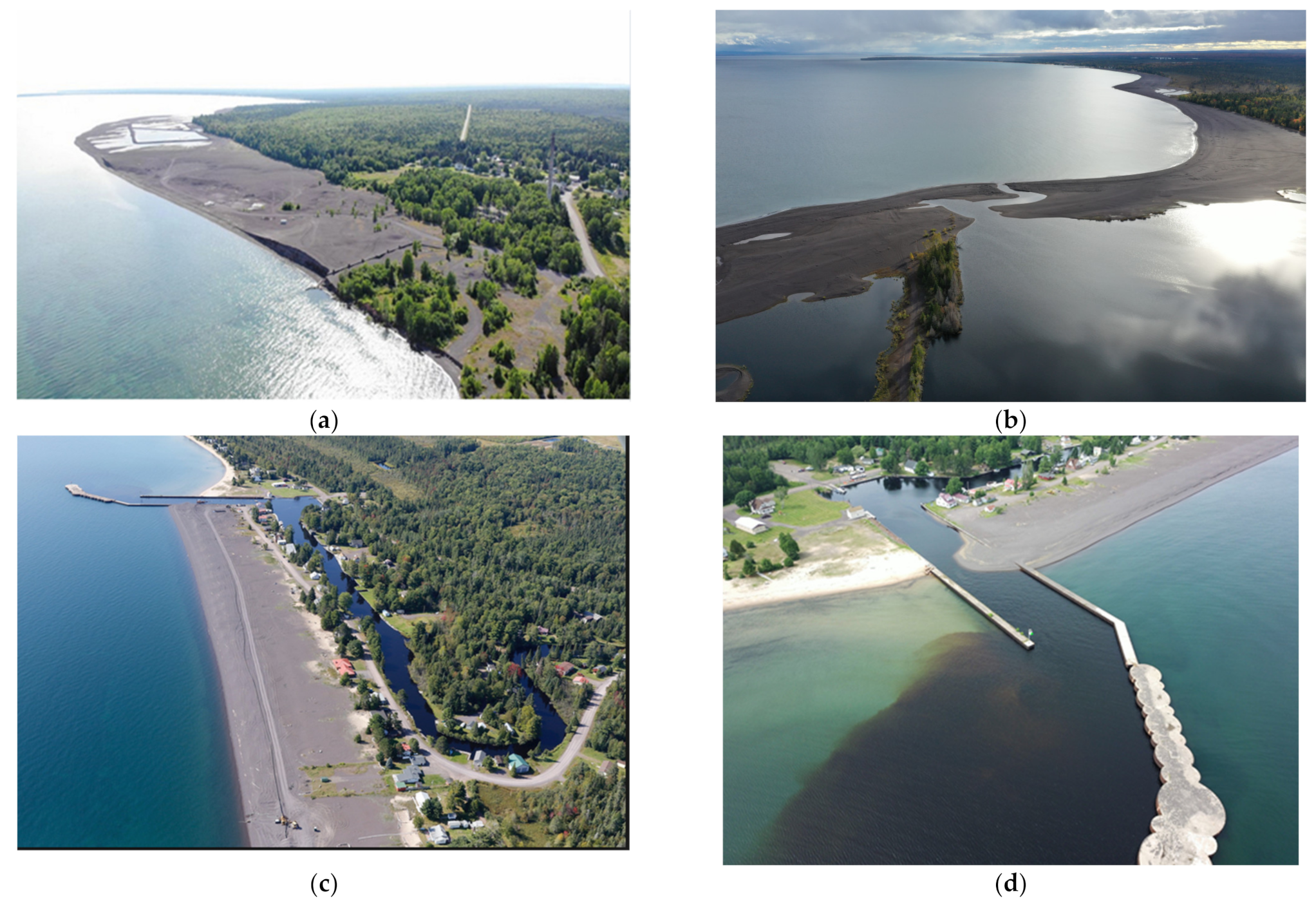
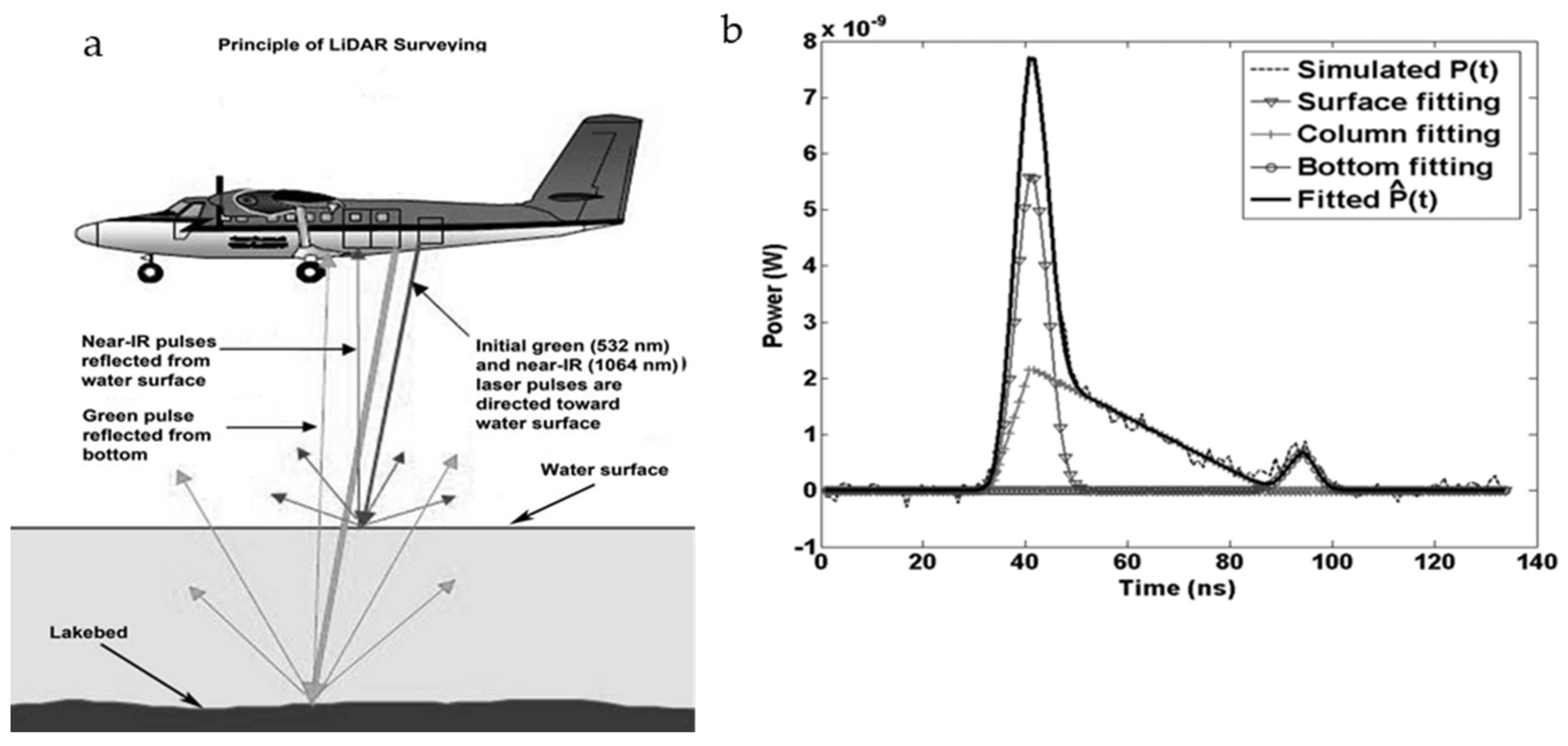
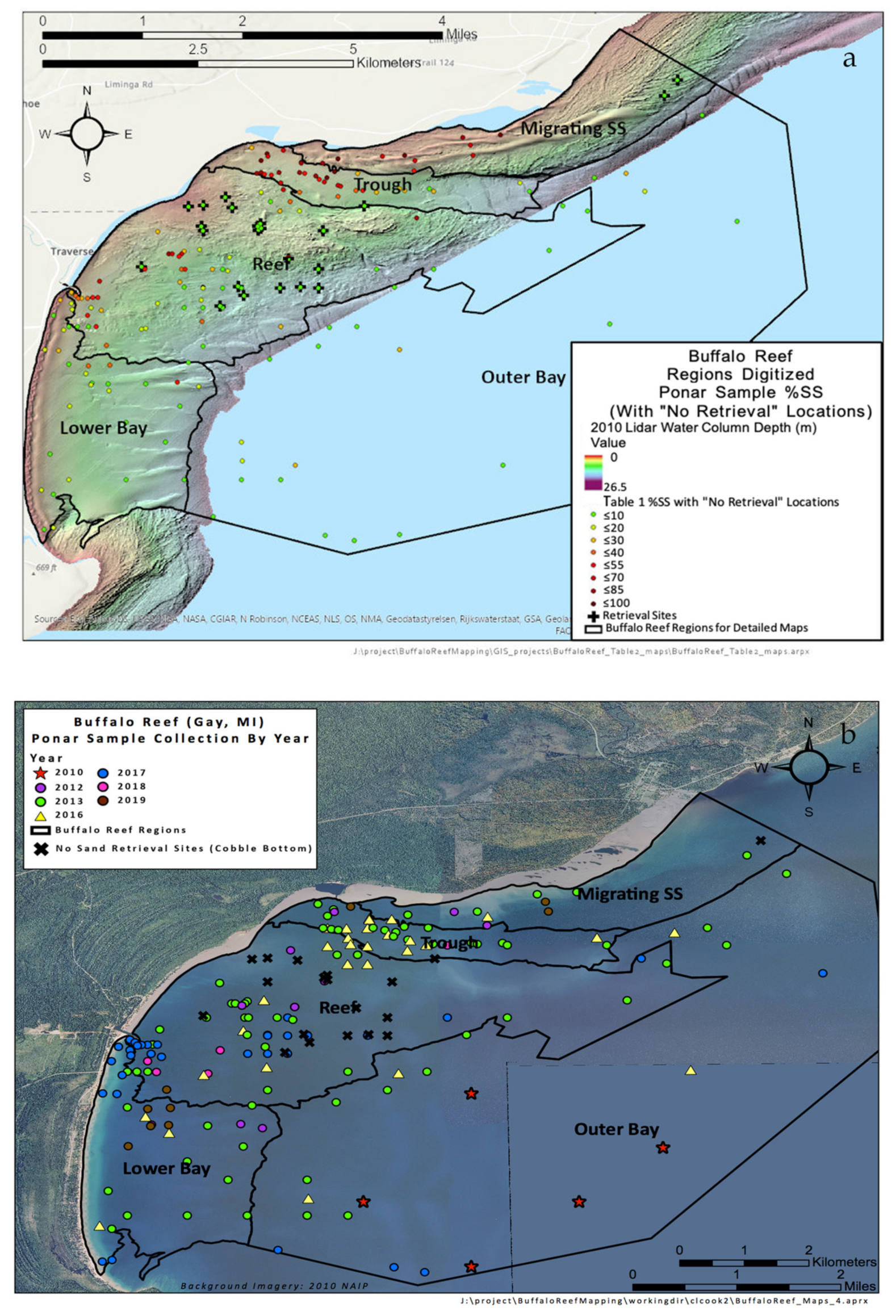
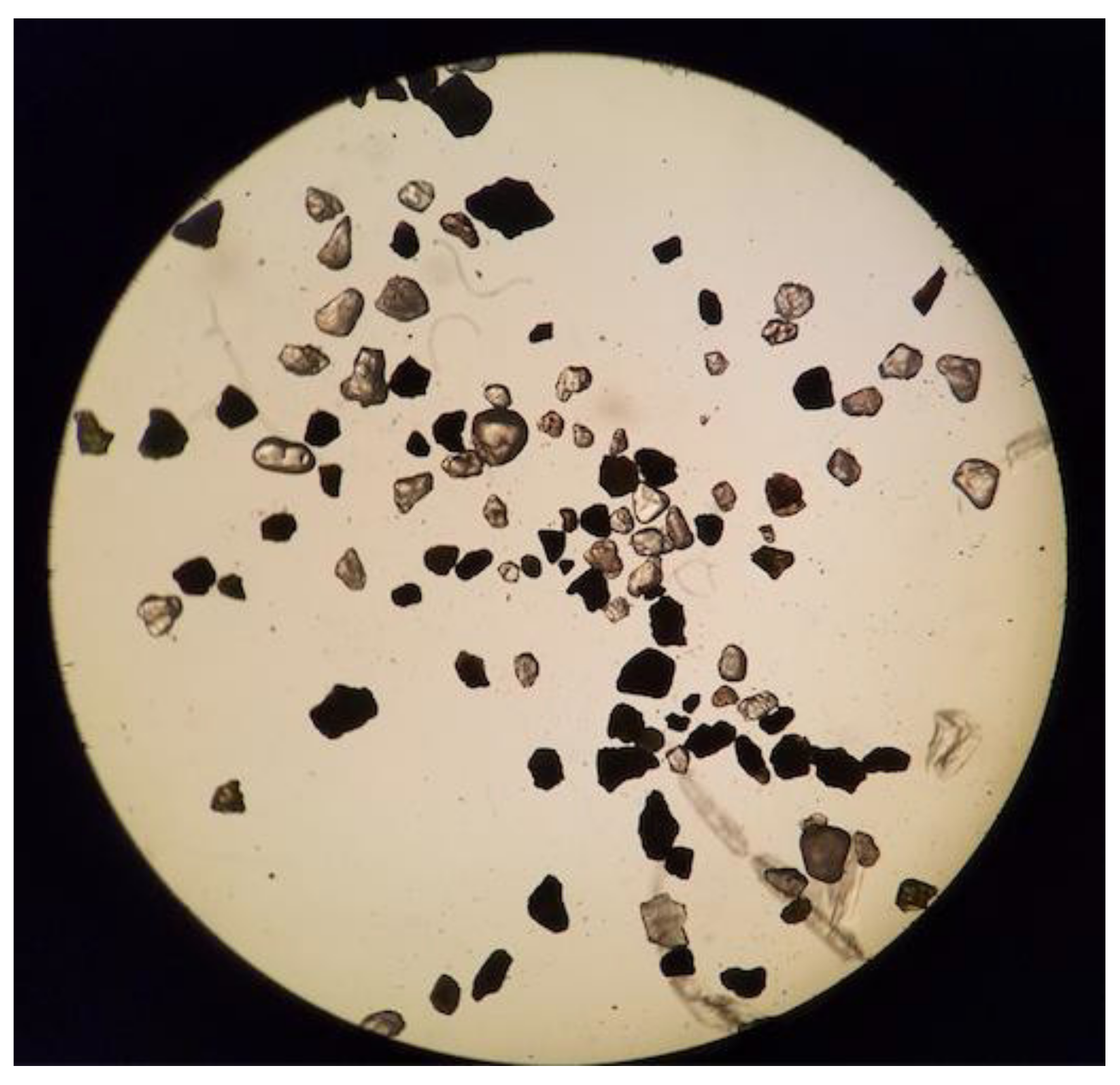
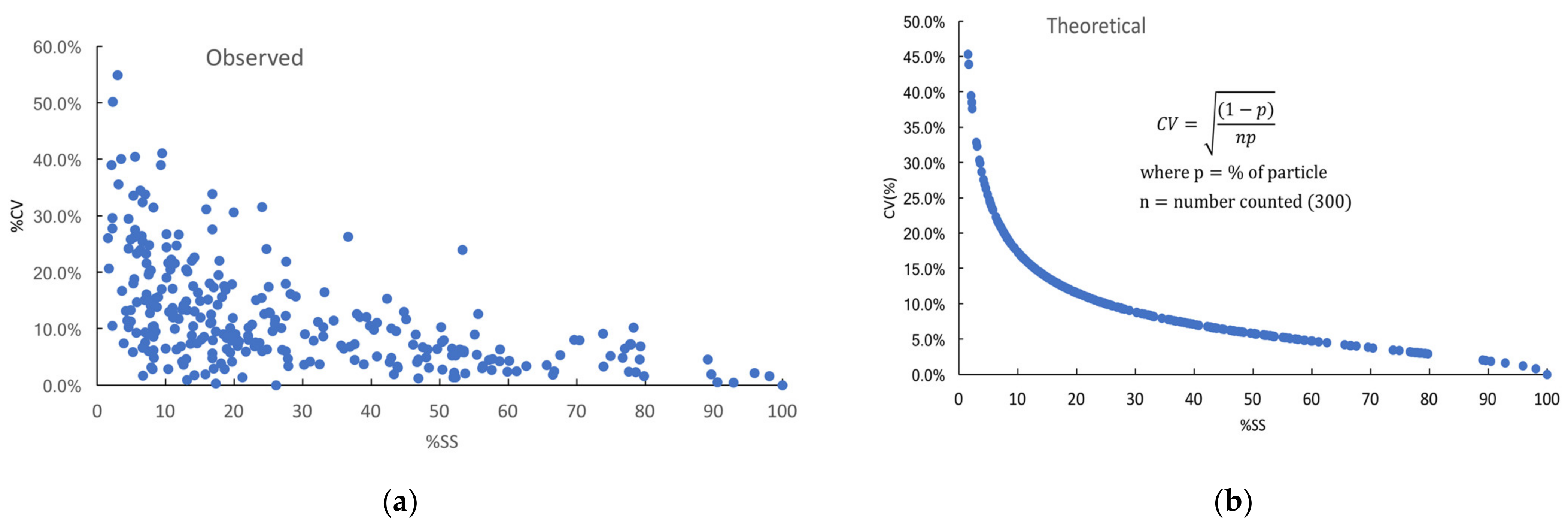
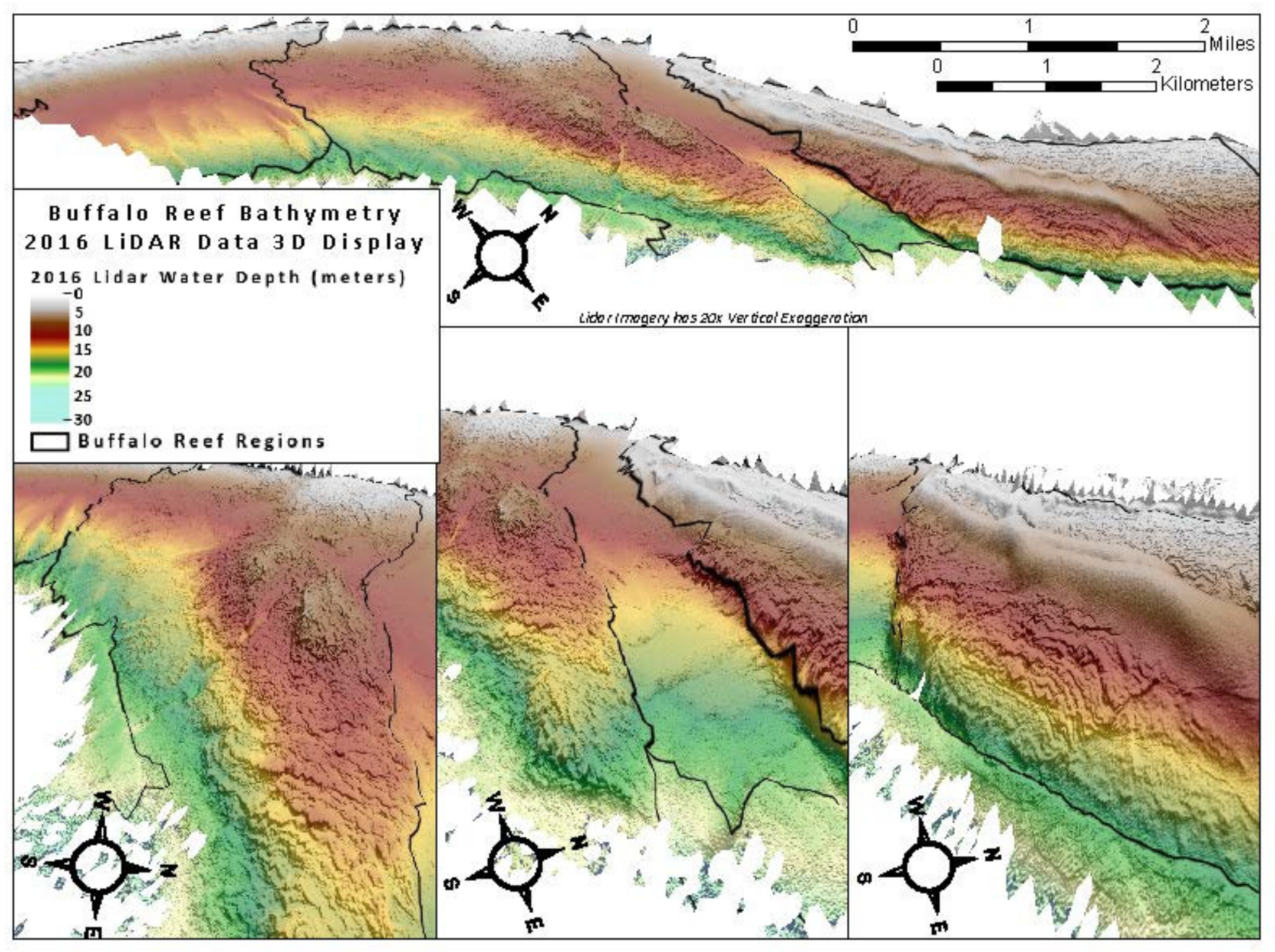
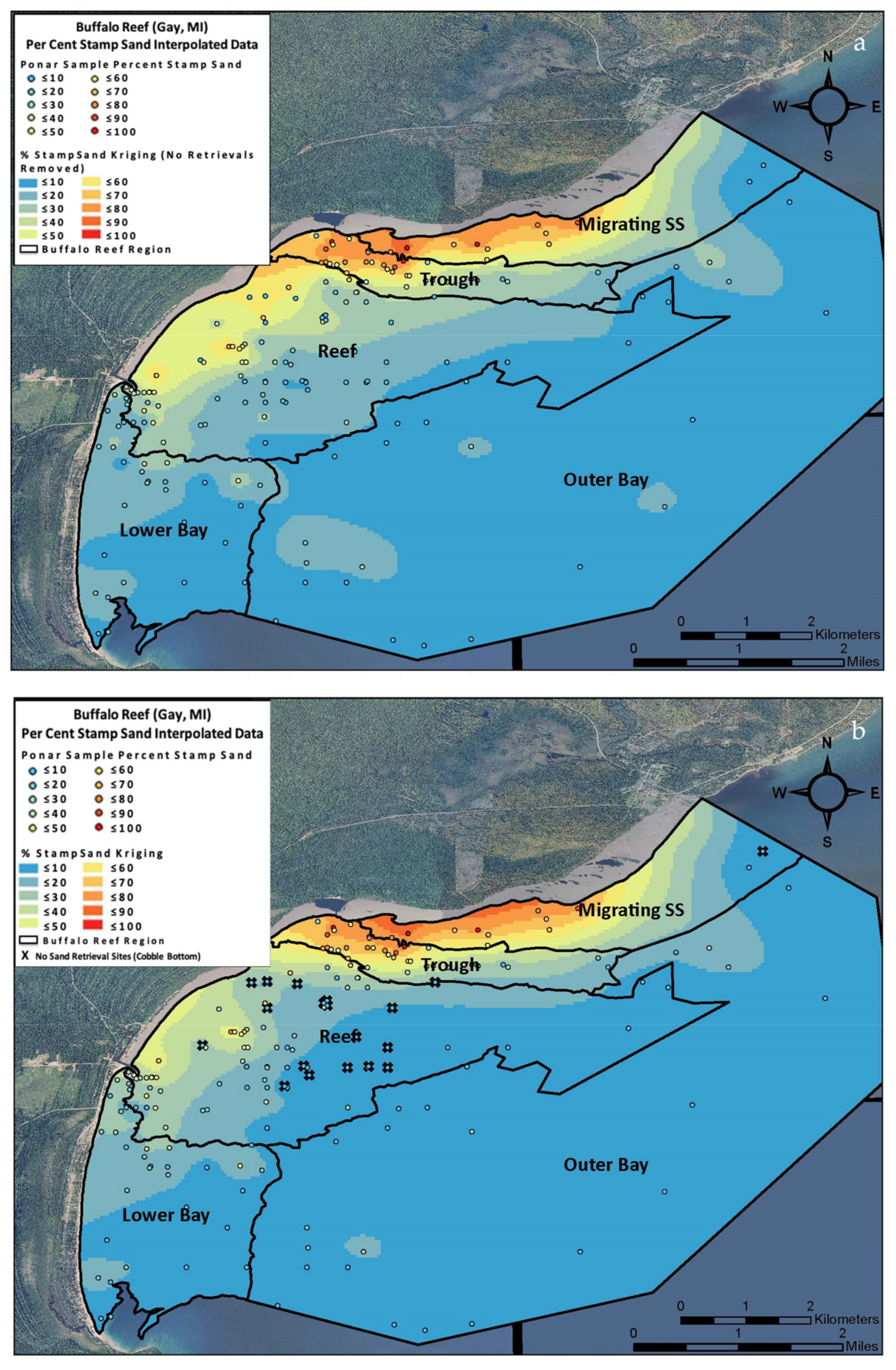
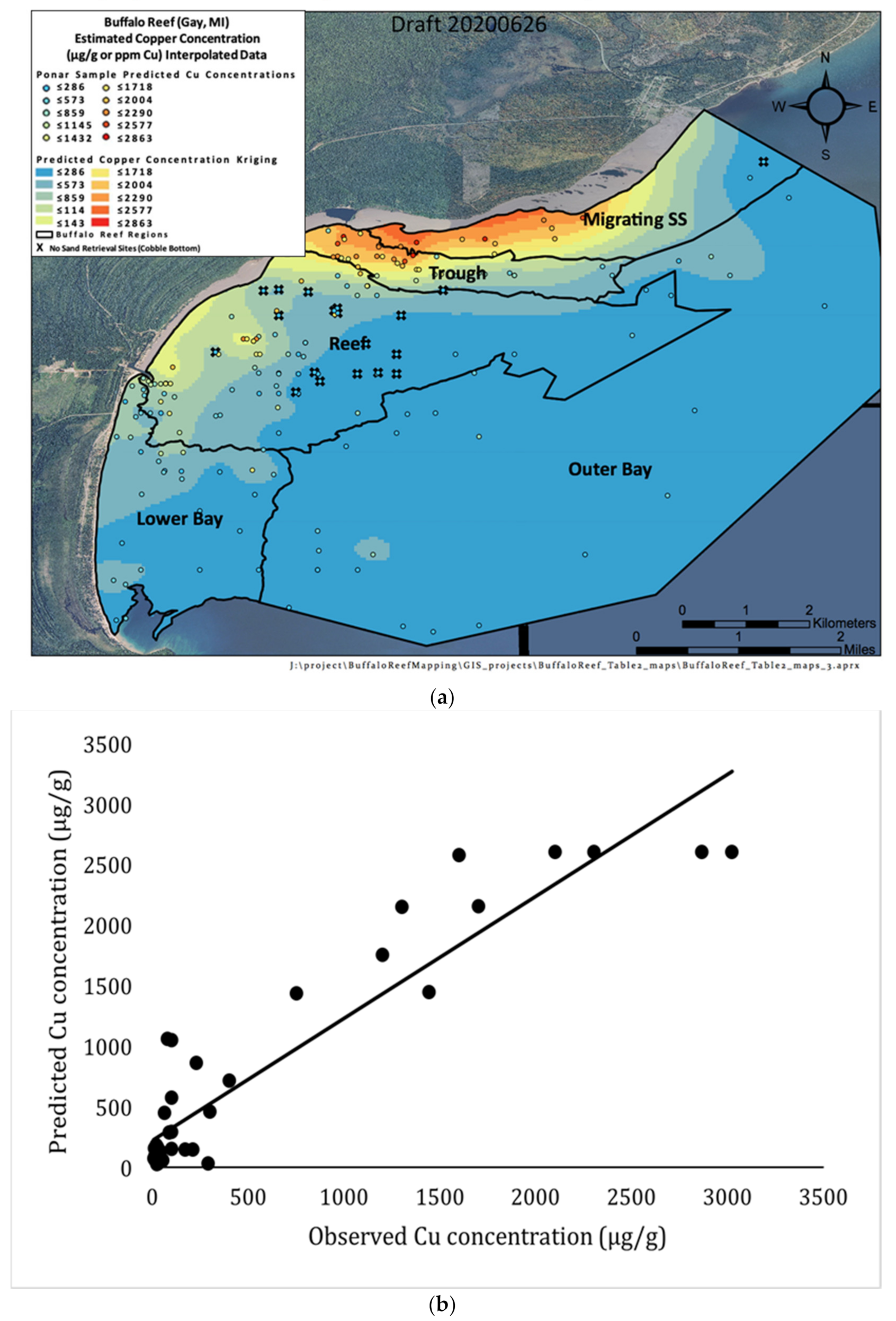

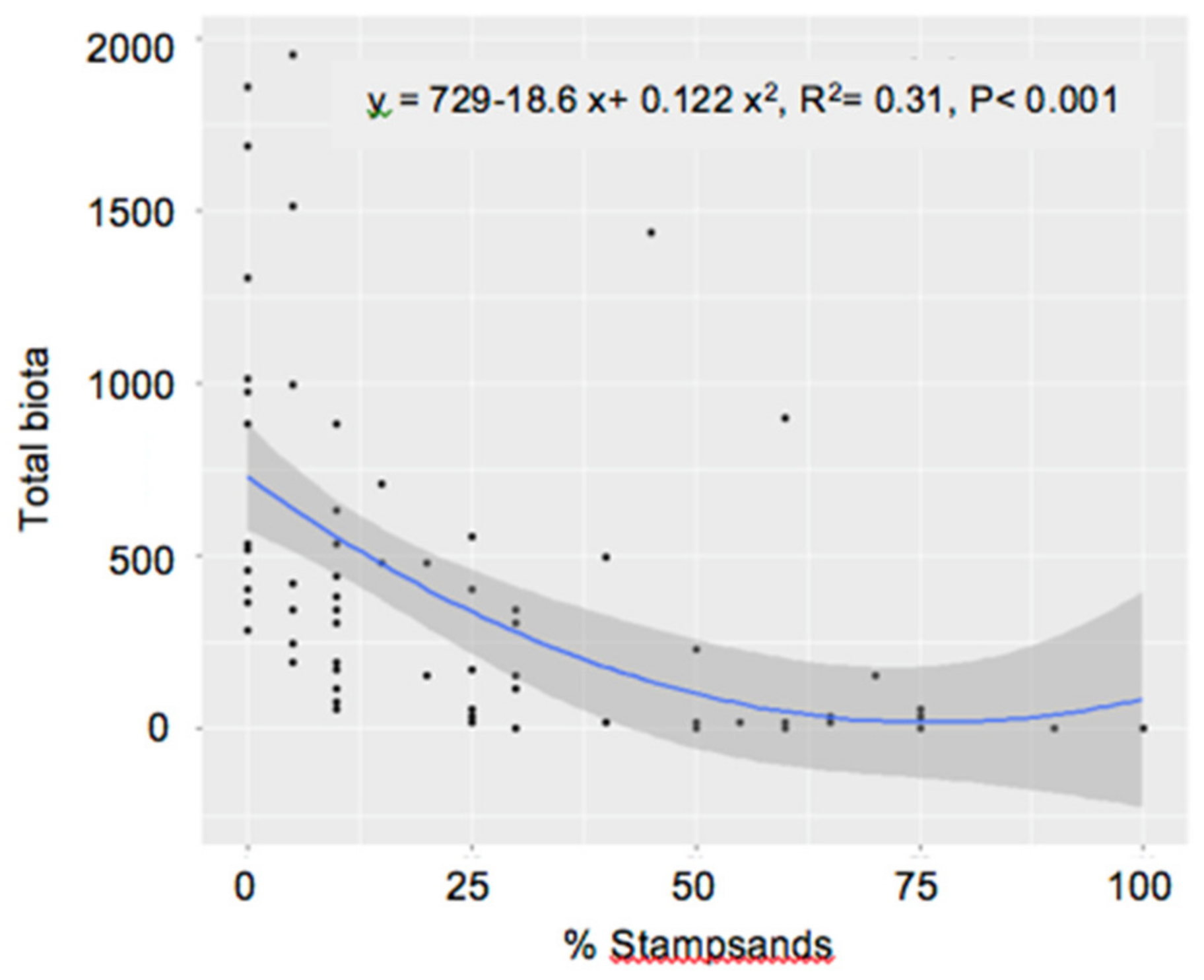


| Device | Box Size | Bite Depth | Dry Weight | Volume | Sample Area |
|---|---|---|---|---|---|
| Petite Ponar | 15 × 15 cm | 70 mm | 11 kg | 2.4 L | 232 cm2 |
| Standard Ponar | 23 × 23 cm | 89 mm | 23 kg | 8.2 L | 522 cm2 |
| Variable | N | Equation | R2 |
|---|---|---|---|
| Density | 64 | y = 0.122x2 − 18.6x + 729 | 0.31 |
| Taxonomic Richness | 46 | y = 0.0003x2 − 0.0646x + 3.8699 | 0.403 |
| Shannon’s H | 53 | y = 0.000118x2 – 0.0215x + 1.0973 | 0.367 |
Publisher’s Note: MDPI stays neutral with regard to jurisdictional claims in published maps and institutional affiliations. |
© 2021 by the authors. Licensee MDPI, Basel, Switzerland. This article is an open access article distributed under the terms and conditions of the Creative Commons Attribution (CC BY) license (https://creativecommons.org/licenses/by/4.0/).
Share and Cite
Kerfoot, W.C.; Hobmeier, M.M.; Swain, G.; Regis, R.; Raman, V.K.; Brooks, C.N.; Grimm, A.; Cook, C.; Shuchman, R.; Reif, M. Coastal Remote Sensing: Merging Physical, Chemical, and Biological Data as Tailings Drift onto Buffalo Reef, Lake Superior. Remote Sens. 2021, 13, 2434. https://0-doi-org.brum.beds.ac.uk/10.3390/rs13132434
Kerfoot WC, Hobmeier MM, Swain G, Regis R, Raman VK, Brooks CN, Grimm A, Cook C, Shuchman R, Reif M. Coastal Remote Sensing: Merging Physical, Chemical, and Biological Data as Tailings Drift onto Buffalo Reef, Lake Superior. Remote Sensing. 2021; 13(13):2434. https://0-doi-org.brum.beds.ac.uk/10.3390/rs13132434
Chicago/Turabian StyleKerfoot, W. Charles, Martin M. Hobmeier, Gary Swain, Robert Regis, Varsha K. Raman, Colin N. Brooks, Amanda Grimm, Chris Cook, Robert Shuchman, and Molly Reif. 2021. "Coastal Remote Sensing: Merging Physical, Chemical, and Biological Data as Tailings Drift onto Buffalo Reef, Lake Superior" Remote Sensing 13, no. 13: 2434. https://0-doi-org.brum.beds.ac.uk/10.3390/rs13132434









